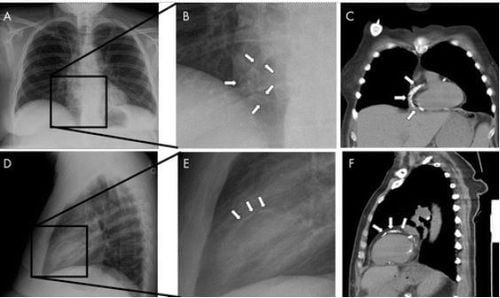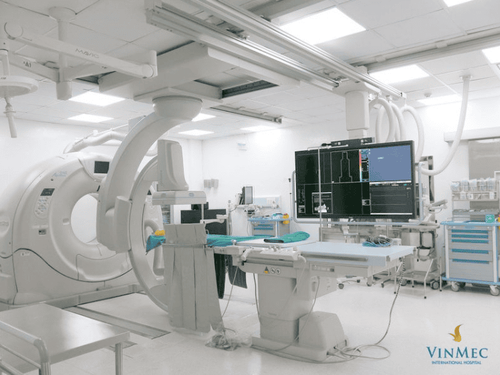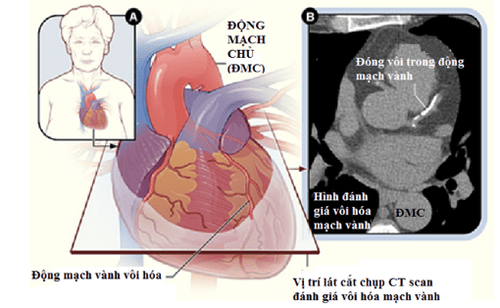This is an automatically translated article.
Article by Master, Doctor Hoang Van Lan Duc - Doctor of Radiology - Department of Diagnostic Imaging and Nuclear Medicine - Vinmec Times City International Hospital.
Can we use chest radiographs to identify underlying coronary artery disease? According to a study published in the journal Cardiothoracic Imaging, artificial intelligence (AI) can identify this.
In a study by Johns Hopkins University in Baltimore, radiologists developed a deep convolutional neural network (DCNN) that not only identified coronary artery calcification on chest radiographs but also to calculate the risk for coronary artery disease. Furthermore, it works independently of traditional risk factors, like smoking or diabetes.
Dr. Peter Kamel, author of the study writes, “we demonstrate that DCNN can detect coronary artery calcification on chest radiographs, although with low sensitivity, this correlates with disease risk. coronary artery of each specific patient”.
Previously, AI was used in the automatic calculation of coronary artery calcification score (Agatston scale) from CT scans. However, CT scans have a higher cost and radiation exposure than conventional chest X-rays. An automated method of screening coronary artery calcification on chest radiographs could provide clinically meaningful prognostic information in patients with underlying coronary artery disease.
What is the coronary calcification score (Agatston scale)?
Coronary calcification score is a quantification of coronary artery calcium severity due to atherosclerosis, it can predict future cardiovascular events and all-cause mortality in at-risk patients. coronary artery. The coronary calcification score can be used in conjunction with data from the Multiethnic Atherosclerosis Study (MESA) to derive the calcification score percentile for patients of the same age and sex. and race without clinical cardiovascular disease.
Coronary calcification score is usually performed on non-contrast, electrode-enhanted cardiac CT, and is calculated using the area of calcification in cross-sections weighted by density (ratio) weight) of CT.
Although the prognostic value of coronary artery calcification has been demonstrated in the past on radiographs prior to the advent of CT coronary calcification, the evaluation and reporting are random, especially in patients without suspected coronary artery disease.
In this study, Kamel and colleagues asked whether an automated DCNN model could detect the presence of coronary calcium on chest X-ray, and whether it was associated with risk cardiovascular disease or not?

They collected imaging data from over a thousand patients who received both CT coronary calcification and chest X-ray. The CT scan is aimed at cardiovascular risk stratification, while the chest X-ray is done for different indications, such as chest pain, cough, and shortness of breath.
Total Agatston calcium score measured on CT and scores of each coronary artery (left coronary artery, anterior interventricular artery, circumflex artery and right coronary artery) were determined to establish standard parameters, then used it to train the AI on chest radiographs. The AI will be trained to know if there is calcification on chest X-ray or no coronary calcification, which coronary arteries are calcified, and the total calcification score is above or below different thresholds. The results of the classification of the trial images were compared with the established 10-year atherosclerotic cardiovascular disease risk scores in each cohort.
Research results show that, with the case of AI detected on X-ray film with coronary calcification, the risk of coronary heart disease in 10 years is 17.2% higher than that of 11.9% in the group without detection. Calcification was found (Agatston score = 0), (with p < 0.001). With multivariable regression method, the algorithm can predict calcium score independent of traditional cardiovascular risk factors.
AI also has some limitations when detecting coronary calcification, such as it will be noisy when the patient has a defibrillator, or has a coronary artery stent. Of course, in this case the detection and calculation of the coronary calcification score becomes secondary to the patient's cardiovascular history.
With current results, AI's accuracy in identifying coronary calcification and correlation with cardiovascular risk remains modest. However, the study serves as a proof of concept that DCNN or AI can identify coronary artery calcification and cardiovascular risk on chest X-rays that conventional radiologists miss. For example, regular chest X-rays are indicated in the initial assessment of chest pain in the emergency department, if using AI to determine the presence of coronary artery calcifications could be useful in guiding guide further diagnostic evaluation in the acute setting.
The results of this study can serve as a pilot for future applications of AI. The study's authors conclude: "Here, we demonstrate that the ability to extract information from medical images that is not readily captured on human evaluation can affect clinical management and the diagnosis.
Currently, Vinmec Time City Hospital has modern x-ray equipment, with research on applying AI in chest radiography being implemented with Vinbrain's DrAid software, patients with and without suspicious symptoms Suspected coronary artery disease can detect early coronary artery calcifications with small-scale calcifications that are often overlooked by the reader's eyes, thereby helping to guide assessment and timely management.
Please dial HOTLINE for more information or register for an appointment HERE. Download MyVinmec app to make appointments faster and to manage your bookings easily.














